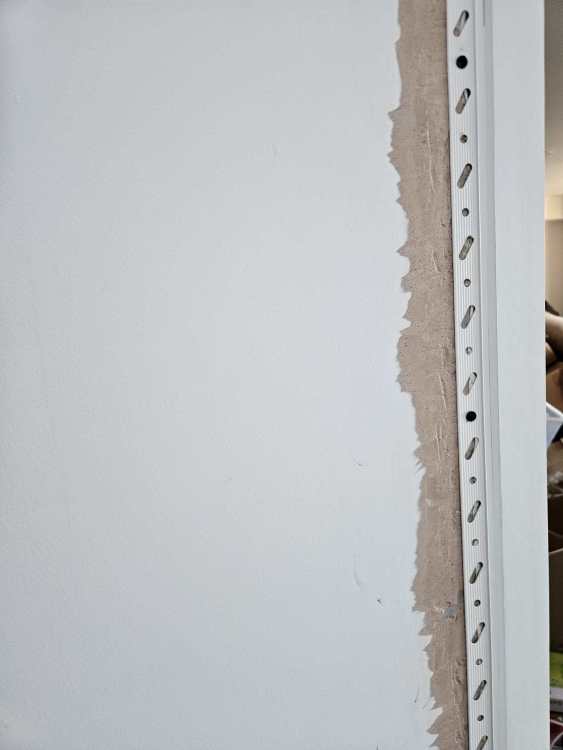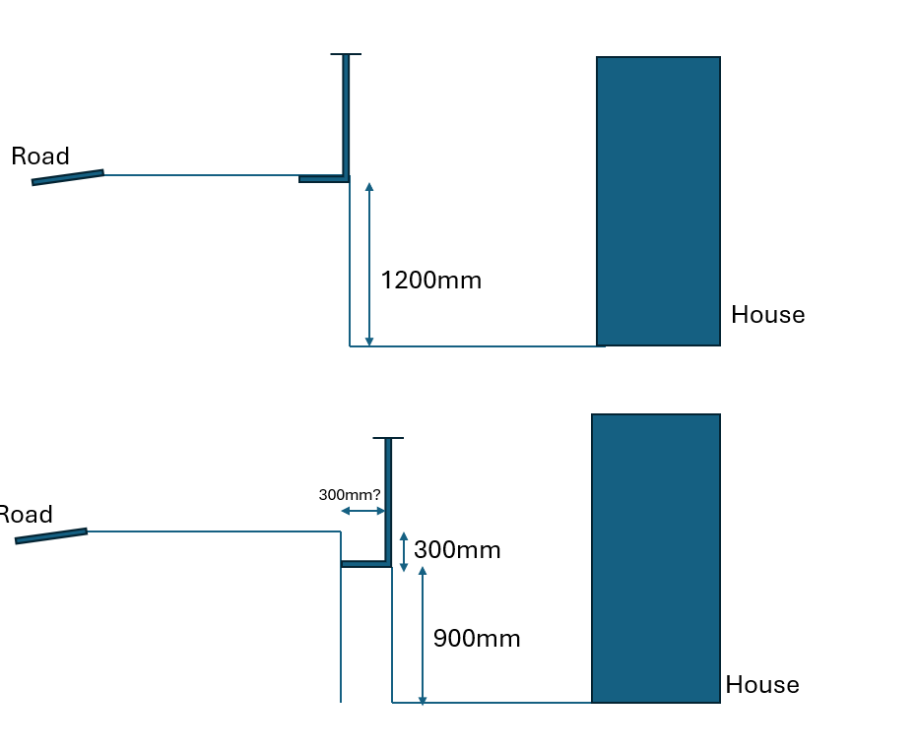
SB2023
Members-
Posts
47 -
Joined
-
Last visited
Recent Profile Visitors
The recent visitors block is disabled and is not being shown to other users.
SB2023's Achievements

Member (3/5)
10
Reputation
-
Fitting shadow gap profile after plastering...
SB2023 replied to SB2023's topic in Plastering & Rendering
Haha 😂 that is what I thought someone might say.... I just couldn't say it myself. -
I ask this knowing that everyone will probably just shake their head in despair at me... I know I got things all out of order. I am fitting (I hope) a shadow gap profile around my internal doors like the first picture. However, in our rush to move in and get things sorted, the plaster-boarder and plasterer have plastered all the way up to the frame without the profile being fitted. As you can see in the first picture, I have chipped back the plaster so it will all blend ok. But this took me days! Has anyone got a better idea? I assume fitting the profile onto the plastered wall will give an awful bump in the plaster.... Could I cut out say 10cm of plasterboard all around the door and refit what is needed and plaster fresh? Or will this just cause loads of cracking in future? Any thoughts before I give up and just fit architrave!? Thanks!!
-
Hi all I know this is not recommended, but its how we plan to solve our small stair issue... Can anyone recommend the best glue that would work between the foam back on korlok LVT planks (they are the floating floor, not glue down ones) to bond it to concrete? There is too much choice out there and all the best recommendations are USA based products like loctite P300 foamboard or Shaw T180. Background: Our staircase is a concrete staircase (I have primed it, so I dont think water based adhesives will work). Plans were for wood floors but last minute changes and new screed heights mean this is not possible. I am routing the backs of the plank so I can fold an internal mitre type joint in it - have done a few trials and works well, plus miles cheaper than buying ready made ones (that dont actually exist in our floortype). Appreciate any input.
-
That could work too. I guess then the plaster can feather in to that from the bead to make the wall seamlessly plastered again.
-
I almost re-worded my note. Just to be clear - it will be a professional plasterer doing it. He is away for a few weeks but I want to get on with prep if its feasible... Sounds like it is which is good news! Just not sure then how best to chip some of the plaster away from the plasterboard then. Maybe sliding a small chisel around...
-
Hi all A plastering question... I didnt really think through everything in time/properly.... We have a shadow gap (flush skirting, 25mm gap using QIC trims and then plasterboard). The walls have been boarded and plastered up to the rough opening but no door linings in yet. I am looking at fitting the door linings and using the QIC trims around the doors to create the shadow gap around the door without architraves. Can I cut back the plaster somehow, fit the trims and re-plaster neatly or is this a really bad idea?? Thanks! Doug
-
Fall on supply and exhaust pipes
SB2023 replied to SB2023's topic in Mechanical Ventilation with Heat Recovery (MVHR)
Thanks Mike! Appreciate the thoughts. Given me some ideas and direction! -
Fall on supply and exhaust pipes
SB2023 replied to SB2023's topic in Mechanical Ventilation with Heat Recovery (MVHR)
A vertical condensation trap looks like it might completely resolve the risk here. That might open up my options and should probably be fitted regardless. Not sure why bpc didn't include/suggest it as they knew it was venting vertically through the roof! -
Fall on supply and exhaust pipes
SB2023 replied to SB2023's topic in Mechanical Ventilation with Heat Recovery (MVHR)
Fair point on the airtight bit! The zehnder doesn't seem to talk about a drain on the outgoing/incoming pipework in their manual that I can see. Will look again. -
Thought I would update this in case anyone stumbled upon it... Trick 1: don't roll the pipe behind you over your shoulder, this naturally makes it bend up.... Keep the pipe coil laid flat and roll out it out from the side. This is why UFH companies have those decoiler things! Trick 2: I used some large round plastic insulation washers and concrete screws to hold the really bad bits down into the concrete slab. Trick 3: as Mike said above, punch through some UFH staples. This works well when not near corners where it could lift the whole insulation and crate up. Trick 4: don't stress too much. One water is in and the screed goes over, you wonder why you worried so much.... Trick 5: don't use egg crates!
-
Fall on supply and exhaust pipes
SB2023 replied to SB2023's topic in Mechanical Ventilation with Heat Recovery (MVHR)
I did think about this but worried that a drain would also let air escape, it wouldn't be truly airtight if the water needs to get out? -
Hi all Having a bit of space challenges with mvhr incoming supply and external exhaust pipes. It would make things a lot simpler if my exhaust pipe to outside could have a slight dip in it but I am worried if this will cause a mould/moisture collection point. Is that a concern? The pipe would come vertically out of the mvhr unit then run 1.5m with a slight downward fall (to avoid rafters) then .5m vertically up and out the roof. All of this is inside a warm insulated roof space that is effectively part of the house. Thanks!
-
Thanks all, interesting points! Looks like a conversation with building control before I do anything as it could potentially save a bunch of work ! Or not... Appreciated!
-
Hi all I cant see a similar question on the forum on this... I know no-one can give Building Regs advice but wondering if this is a daft idea or someone has something ingenious... On our new build, we have a retaining wall at the front and then a drop to the house like in the top picture and it shows where a railing would need to be. This then is quite an eyesore from the road with railings blocking out the view of the house. I am considering (see the second diagram) building another wall in front of the existing one that would just retaining a small flower bed and put the railings on that as in picture two. This would lower the railing height noticeably. Anyone got any thoughts on this at all? Or know if it should be building regs ok? The aim is to really get the railing down as low as possible and still be safe!
-
Hi all Having a mini meltdown in a race against the clock for screeders coming. We were specified egg crates upstairs as we only have 20mm insulation and none in some areas. I am laying the pert pipe and absolutely losing my mind. Every 90 degree corner I do causes the egg crate to lift. It goes back down easy enough if I press it but obviously it can't be like this for the screed. Am I missing a trick? Appreciate any insight!




